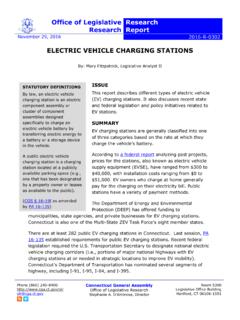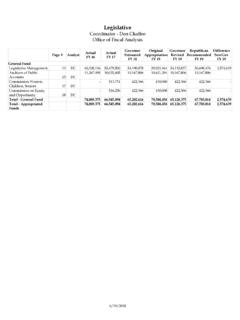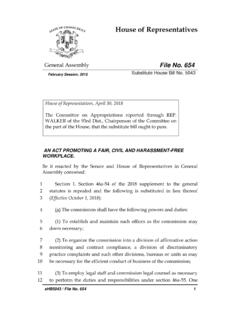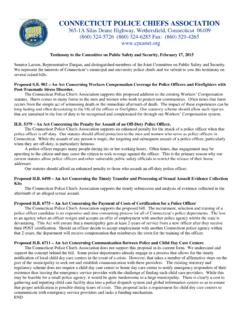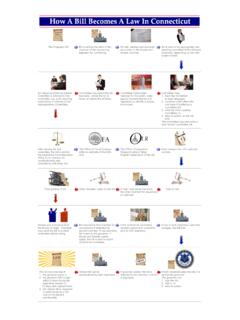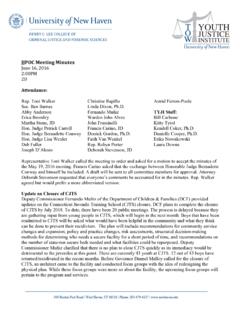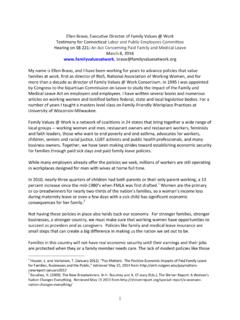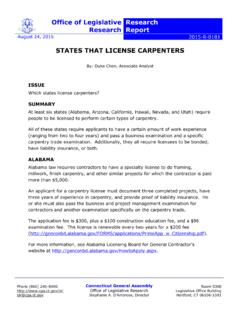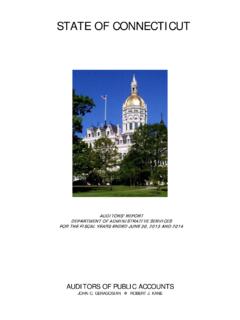Transcription of The taxation of registered motor vehicles in Connecticut
1 The taxation of registered motor vehicles in Connecticut Draft November 6, 2015. Lawrence C. Walters Romney Institute of Public Management Brigham Young University Presentation November 17, 2015. The cooperation of the following local assessors is gratefully acknowledged in providing both data and insights into assessment practices in Connecticut : Lucy Beit (Montville), Michael Bekech (Waterford), Melissa Bonin (Killingly), Damon Braasch (Middeltown), Joseph Dakers Sr. (West Hartford), Lauren Elliott (Greenwich), Mary Gardner (Groton), Lawrence LaBarbera (Windsor), John Philip (Hartford), Donna Ralston (Norwich), Donald Ross Jr.
2 (Fairfield), Greg Stackpole (Stamford), and Walter Topliff (Bloomfield). All responsibility for errors, omissions and misunderstandings remain the responsibility of the author. i Table of Contents Executive Summary .. iii Options .. iv Introduction .. 1. The Connecticut Car Tax .. 2. Discovery .. 2. Valuation .. 3. Tax rates .. 5. Billing and collection .. 7. Taxing motor vehicles in other states .. 7. Administrative challenges .. 10. Valuing specialized vehicles and mounted equipment .. 11. Treatment of antique 11. vehicles sold or disposed of during the tax year .. 12. vehicles relocated out of state .. 12. Registering Connecticut vehicles in other 12.
3 Options and observations .. 17. Concluding observations .. 23. References .. 24. i List of Tables 1. Connecticut registered motor vehicles and Assessed Value 3. 2. Percentages used to calculate the supplemental motor vehicle tax .3. 3. Cities with the largest revenue loss under the new state motor vehicle mill rate cap .6. 4. State treatment of motor vehicles 8. List of Figures 1. Net motor vehicle assessed value as a percent of total net Grand List 2. 2. Net motor vehicle assessments as a percent of total net Grand List: 2013 ..4. 3. motor vehicle exemptions as a percent of total motor vehicle assessed value 5. 4.
4 motor vehicle tax on $20,000 vehicle : Illustration .6. 5. Number of registered motor vehicles ..10. 6. Connecticut registered motor vehicles and usage .. 13. 7. vehicle registrations per capita ..14. 8. Assessed values and mill rates ..15. List of Boxes 1. Excise tax example . 19. 2. The equity of a fixed percentage assessment exemption .. 20. 3. Replacing a fixed percentage assessment exemption with a fixed dollar exemption ..21. ii Executive Summary registered motor vehicles represent of the total net Grand List value in Connecticut . The tax on motor vehicles currently yields over $650 million each year across the state, or nearly $183 per capita.
5 The Connecticut motor vehicle property tax system can be summarized as follows: o In 2013, there were million registered vehicles in Connecticut with an aggregate gross taxable value of $23,690 million. Net motor vehicle assessments as a percent of total net Grand List value varies across cities from less than 3% to over 16%. o vehicles are valued at 70% of average retail value based on NADA data as of October 1 each year. vehicles acquired after October 1 and before July 31 are valued on a supplemental valuation list. o Variations in local mill rates result in very large differences in the tax obligation associated with vehicles of the same value based solely on the address of the owner.
6 O The new 32 mill state rate cap will result in about $67 million in lost revenue. About 74% of this amount will occur in 10 cities. The state has committed to replace the lost revenue with sales tax receipts. Other states vary widely in their tax treatment of motor vehicles o Eleven states levy an ad valorem tax on motor vehicles similar to Connecticut 's. Two other states levy an ad valorem tax on at least some vehicles . o Twelve states levy an excise tax based on age-adjusted Manufacturer's Suggested Retail Value when new. o Nine other states have variations on these two approaches. o The remaining 16 states levy no tax on motor vehicles beyond modest registration fees.
7 Administration of the motor vehicle tax in Connecticut faces several significant challenges. As a result of the combination of these factors, the majority of resources in a local assessor's office are devoted to maintaining motor vehicle accounts and values. o Assessors must estimate the average retail value for million vehicles each year. o About 70% of these values can be estimated using published NADA data. o The remaining vehicles are often specialized or have specialized equipment for which valuation data is difficult to obtain. o vehicles sold during the year are often eligible for a prorated tax credit. Credits for approximately 360,000 vehicle sales each year must be processed manually.
8 O vehicles relocating out of state are also eligible for a prorated credit. All of these approximately 75,000 credits must be processed manually. o There are claims that some Connecticut residents are registering their vehicles out of state to avoid the vehicle property tax. The evidence for this claim at this point is inconclusive. o There is a pronounced negative correlation between city mill rates and the total motor vehicle assessed value per capita. Towns with high mill rates also show a much lower number of vehicles per 100 population. This evidence is consistent with the broader claim that behaviors are changed by the current tax.
9 Essentially any approach that attempts to both promote increased equity and remain revenue neutral will create large numbers of taxpayers with higher tax obligations enroute to reducing the tax bills for other vehicle owners. There are only a few courses of action available: Increase the taxes paid by some in order to achieve uniformity and equity statewide Continue the current course of capping the maximum tax rate (and therefore the amount of acceptable inequity) and either iii o replace the lost revenue from state resources or o provide local governments with an alternative revenue source under local control Abandon the tax on motor vehicles as a significant source of revenue and either replace the lost revenue or provide local governments with an alternative revenue source.
10 Mandate equity in motor vehicle taxation , phased in over a sufficient time period to allow local governments to adjust to lower revenues, higher taxes on the remaining property tax base or a combination of both Options The options that might be considered regarding the taxation of motor vehicles include: Option 0: The status quo Option 1a: A revenue-neutral statewide mill rate and hold harmless provision to replace the lost revenue in some cities. The required revenue-neutral mill rate would be about mills. Significantly, 73 communities would see taxes on motor vehicles increase by an average of about At the same time, 96 communities would receive tax reductions of about on average.
